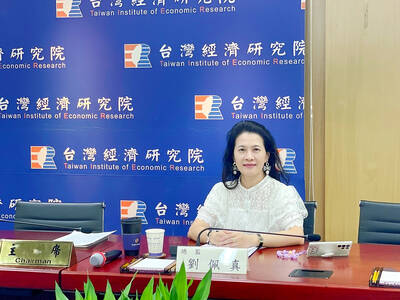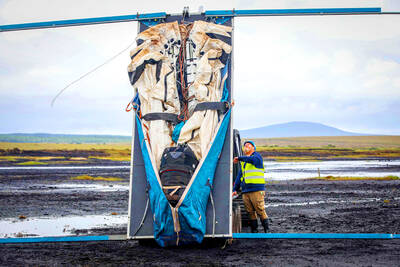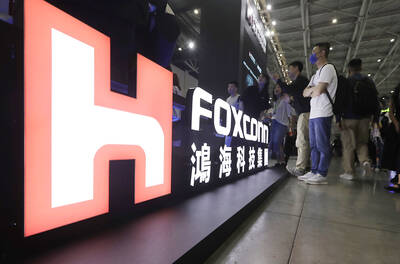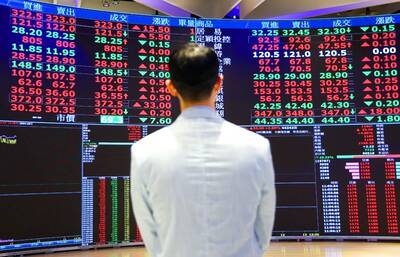The number of workers on unpaid leave at Hsinchu Science Park has dropped by nearly 60 percent to 40,933 from a high of about 100,000, because of increasing orders and rising capacity utilization rates, administrators said on Sunday.
Miin Wu (吳敏求), chairman of chipmaker science park based Macronix International Co (旺宏電子), told President Ma Ying-jeou (馬英九) during a visit on Sunday that the firm had begun to reverse its policy of unpaid leave last month and even planned to hire another 150 engineers — 50 for the research and development department and 100 for the manufacturing department.
Macronix president Lu Chih-yuan (盧志遠) said the company’s factory usage was rising fast and may reach full utilization next month.
However, as customers are conservative about placing orders amid the economic downturn, most orders were short-term rush orders, Lu said.
As the outlook for the third quarter was unclear, Macronix would not invest in a 12-inch plant until the third quarter, when the prospects may become better, Lu said.
Yen Tzong-ming (顏宗明), director-general of the Hsinchu Science Park Administration, said many statistical indicators showed significant improvement.
Output value in the science park, for example, reached only NT$91.4 billion (US$2.75 billion) in the first two months of this year but the figure was expected to rise to a combined NT$118.8 billion for March and last month, Yen said.
The number of unemployed workers at the science park had declined month by month this year, Yen said. Some 382 people lost their jobs last month, from 1,956 last December, he said.
Yen said many firms located in the science park were forced to implement unpaid leave, after seeing their capacity utilization rate fall to between 30 percent and 40 percent amid falling orders.
As a result, the number of workers on unpaid leave surged to 14,500 in January from 870 in December, Yen said.
Since last month, firms in the park said they had seen a recovery in new orders received, prompting most of the firms there to increase their capacity utilization to between 70 percent and 80 percent, Yen said.
As of Friday, 813 businesses in Taiwan have asked employees to take unpaid leave, Council of Labor Affairs statistics show.
The figure represented the lowest number since the council began to notify the government of the number of workers on unpaid leave in mid-January.
The number reached a peak of 238,975 on March 3.
“The jobless situation is stabilizing for the time being, with local firms receiving short-term rush orders from the inventory restocking process,” HSBC analyst Christopher Wong wrote in a note.
“We expect the unemployment rate, to be released this Friday, to rise marginally to 5.8 percent,” Wong said.

A proposed 100 percent tariff on chip imports announced by US President Donald Trump could shift more of Taiwan’s semiconductor production overseas, a Taiwan Institute of Economic Research (TIER) researcher said yesterday. Trump’s tariff policy will accelerate the global semiconductor industry’s pace to establish roots in the US, leading to higher supply chain costs and ultimately raising prices of consumer electronics and creating uncertainty for future market demand, Arisa Liu (劉佩真) at the institute’s Taiwan Industry Economics Database said in a telephone interview. Trump’s move signals his intention to "restore the glory of the US semiconductor industry," Liu noted, saying that

On Ireland’s blustery western seaboard, researchers are gleefully flying giant kites — not for fun, but in the hope of generating renewable electricity and sparking a “revolution” in wind energy. “We use a kite to capture the wind and a generator at the bottom of it that captures the power,” said Padraic Doherty of Kitepower, the Dutch firm behind the venture. At its test site in operation since September 2023 near the small town of Bangor Erris, the team transports the vast 60-square-meter kite from a hangar across the lunar-like bogland to a generator. The kite is then attached by a

Foxconn Technology Co (鴻準精密), a metal casing supplier owned by Hon Hai Precision Industry Co (鴻海精密), yesterday announced plans to invest US$1 billion in the US over the next decade as part of its business transformation strategy. The Apple Inc supplier said in a statement that its board approved the investment on Thursday, as part of a transformation strategy focused on precision mold development, smart manufacturing, robotics and advanced automation. The strategy would have a strong emphasis on artificial intelligence (AI), the company added. The company said it aims to build a flexible, intelligent production ecosystem to boost competitiveness and sustainability. Foxconn

STILL UNCLEAR: Several aspects of the policy still need to be clarified, such as whether the exemptions would expand to related products, PwC Taiwan warned The TAIEX surged yesterday, led by gains in Taiwan Semiconductor Manufacturing Co (TSMC, 台積電), after US President Donald Trump announced a sweeping 100 percent tariff on imported semiconductors — while exempting companies operating or building plants in the US, which includes TSMC. The benchmark index jumped 556.41 points, or 2.37 percent, to close at 24,003.77, breaching the 24,000-point level and hitting its highest close this year, Taiwan Stock Exchange (TWSE) data showed. TSMC rose NT$55, or 4.89 percent, to close at a record NT$1,180, as the company is already investing heavily in a multibillion-dollar plant in Arizona that led investors to assume